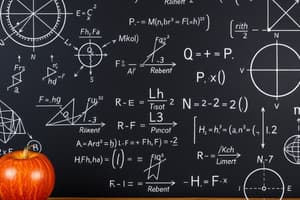Podcast
Questions and Answers
What is the primary focus of data science?
What is the primary focus of data science?
- Development of calculus
- Modeling situations with conflicting interests
- Understanding geometrical shapes
- Analysis and interpretation of large datasets (correct)
Which of the following is a characteristic of non-Euclidean geometry?
Which of the following is a characteristic of non-Euclidean geometry?
- Includes hyperbolic and elliptic geometries (correct)
- Is exclusively two-dimensional
- Follows the parallel postulate
- Contains only right angles
Which period is credited with the development and refinement of algebra?
Which period is credited with the development and refinement of algebra?
- Greek mathematicians
- Ancient civilizations
- Renaissance and beyond (correct)
- Middle Ages
What strategy is crucial for mastering mathematical concepts?
What strategy is crucial for mastering mathematical concepts?
Which learning strategy emphasizes the importance of retrieving information from memory?
Which learning strategy emphasizes the importance of retrieving information from memory?
What is the main focus of algebra?
What is the main focus of algebra?
Which branch of mathematics is primarily concerned with the study of angles and triangles?
Which branch of mathematics is primarily concerned with the study of angles and triangles?
What is an axiom in mathematics?
What is an axiom in mathematics?
Which mathematical concept defines a relationship between input and output values?
Which mathematical concept defines a relationship between input and output values?
What type of proof shows that assuming a statement is false leads to a contradiction?
What type of proof shows that assuming a statement is false leads to a contradiction?
How does calculus primarily analyze phenomena?
How does calculus primarily analyze phenomena?
Which type of number includes whole numbers and their negative counterparts?
Which type of number includes whole numbers and their negative counterparts?
What does the field of statistics focus on?
What does the field of statistics focus on?
Flashcards
Mathematics
Mathematics
The study of quantity, structure, space, and change, using logic and abstraction to understand patterns and relationships.
Arithmetic
Arithmetic
The branch of mathematics dealing with basic operations (addition, subtraction, multiplication, division).
Algebra
Algebra
The branch of mathematics using symbols and rules to solve equations and relationships.
Geometry
Geometry
Signup and view all the flashcards
Calculus
Calculus
Signup and view all the flashcards
Functions
Functions
Signup and view all the flashcards
Proofs
Proofs
Signup and view all the flashcards
Axioms
Axioms
Signup and view all the flashcards
Data Science
Data Science
Signup and view all the flashcards
Game Theory
Game Theory
Signup and view all the flashcards
Euclidean Geometry
Euclidean Geometry
Signup and view all the flashcards
Non-Euclidean Geometry
Non-Euclidean Geometry
Signup and view all the flashcards
Practice problems
Practice problems
Signup and view all the flashcards
Study Notes
Introduction to Mathematics
- Mathematics is the study of quantity, structure, space, and change.
- It uses logic and abstraction to understand patterns and relationships.
- It encompasses a wide range of concepts, from basic arithmetic to complex calculus.
- Mathematics plays a crucial role in various fields, including science, engineering, computer science, and finance.
Branches of Mathematics
- Arithmetic: Deals with basic operations like addition, subtraction, multiplication, and division.
- Algebra: Studies mathematical symbols and the rules for manipulating them to solve equations and relationships.
- Geometry: Explores shapes, sizes, and spatial relationships.
- Calculus: Analyzes change and motion. Includes differential and integral calculus.
- Trigonometry: Relates angles and sides of triangles. Used in navigation, engineering, and more.
- Statistics: Collects, analyzes, and interprets data.
- Probability: Studies the likelihood of events occurring.
Fundamental Concepts
- Numbers: Natural numbers, integers, rational numbers, irrational numbers, real numbers, complex numbers. Each set has specific characteristics.
- Sets: A collection of distinct objects (elements).
- Functions: Defines a relationship between input and output values.
- Equations: Statements of equality between two expressions.
- Inequalities: Statements of inequality between two expressions.
- Proofs: Logical arguments demonstrating the truth of a mathematical statement.
Mathematical Tools and Techniques
- Axioms: Basic statements accepted as true without proof.
- Theorems: Statements proven to be true based on axioms and previously proven theorems.
- Logic: Allows for valid reasoning and deduction.
- Proof by Induction: A way to prove statements are true for all positive integers, starting from a base case and showing the statement holds true for the next value.
- Proof by Contradiction: Shows that assuming a statement is false leads to a contradiction, proving the statement true.
- Mathematical Notation: Using symbols and abbreviations to concisely express ideas.
Applications of Mathematics
- Science: Models natural phenomena, predicting and explaining observations.
- Engineering: Designing structures, analyzing physical systems.
- Computer Science: Algorithms, data structures, cryptography.
- Finance: Investments, risk management, market analysis.
- Data Science: Analysis and interpretation of large datasets.
- Game Theory: Modeling situations with conflicting interests
Different Mathematical Systems
- Euclidean Geometry: A system based on axioms that describe the properties of shapes and figures in a 2-D or 3-D space where parallel postulate exists.
- Non-Euclidean Geometry: Systems where the parallel postulate is not valid, leading to variations of geometrical relations. Includes hyperbolic and elliptic geometries.
Historical Developments
- Ancient civilizations: Used mathematics for practical purposes (agriculture, construction).
- Greek mathematicians: Made significant contributions to geometry and number theory – Euclid, Pythagoras.
- Renaissance and beyond: Development and refinement of calculus, algebra.
Learning Strategies
- Practice problems: Essential for mastering mathematical concepts.
- Understanding concepts: Focusing on "why" instead of just "how."
- Seeking help: Recognizing when clarification is needed from teachers or peers.
- Active recall: Testing yourself regularly and retrieving information from memory.
- Visual aids: Using diagrams, graphs, and other visuals to enhance understanding and retention.
- Connecting with real-world examples: Utilizing applications of mathematics to appreciate relevance.
Studying That Suits You
Use AI to generate personalized quizzes and flashcards to suit your learning preferences.
Description
This quiz provides an overview of various branches of mathematics including arithmetic, algebra, geometry, calculus, trigonometry, statistics, and probability. Discover how mathematics applies to real-world scenarios and its importance across different fields such as science and engineering.




